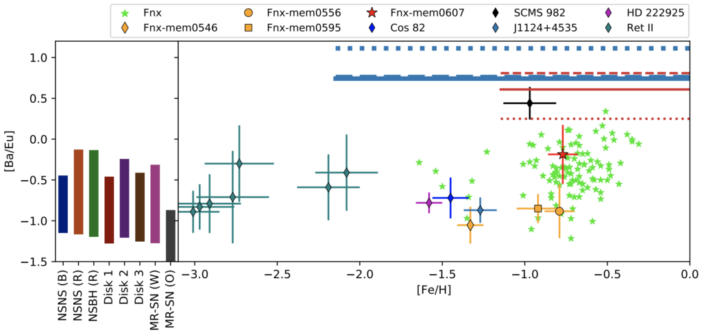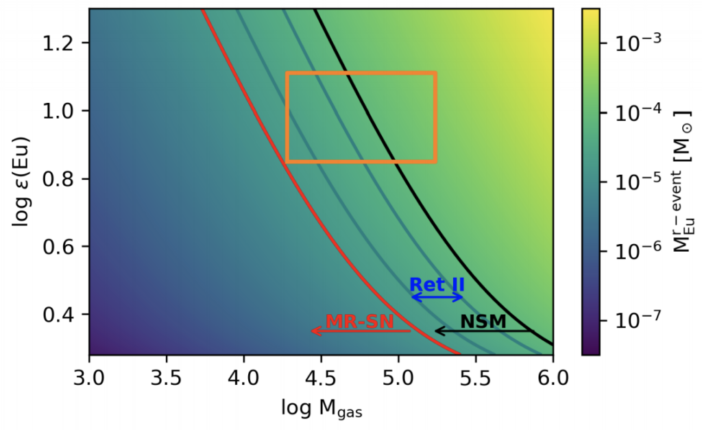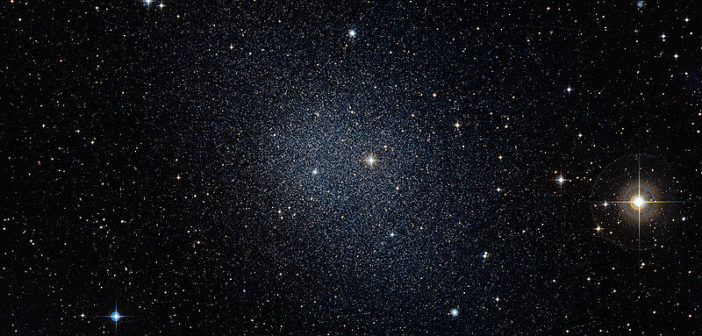Editor’s note: Astrobites is a graduate-student-run organization that digests astrophysical literature for undergraduate students. As part of the partnership between the AAS and astrobites, we occasionally repost astrobites content here at AAS Nova. We hope you enjoy this post from astrobites; the original can be viewed at astrobites.org.
Title: Extreme r-process enhanced stars at high metallicity in Fornax
Authors: M. Reichert, C. J. Hansen, A. Arcones
First Author’s Institution: Technical University of Darmstadt and Helmholtz International Center for FAIR, Germany
Status: Submitted to ApJ
What Are Metals?

Periodic table showing the origin of each chemical element. Those produced by the r-process are shaded orange and attributed to supernovae in this image; though supernovae are one proposed source of r-process elements, an alternative source is the merger of two neutron stars. [Cmglee]
To date, astronomers have studied the presence of heavy elements primarily by looking at the spectra of stars and measuring chemical abundances. Recently, studies of r-process enhanced stars — stars with unusually high abundances of r-process-formed elements — have suggested that many of these stars were born in dwarf galaxies and later accreted onto the Milky Way. To test this scenario and better understand the physics behind r-process enhanced stars, the authors of today’s paper turned toward our neighbor, the massive dwarf spheroidal galaxy Fornax.
Odd Ones Out
In their study of the stellar populations of Fornax, the authors found three stars with significantly enhanced r-process elements as compared to the rest of the population. In particular, the abundance of the rare element europium (Eu) is roughly an order of magnitude higher than for other stars in Fornax. For this reason, the authors refer to them as Eu-stars. Figure 1 shows these Eu-stars compared with normal Fornax stars and other r-process enhanced stars. There is a general trend between metallicity ([Fe/H]) and the absolute Eu abundances, which holds true for both the r-process enhanced and comparison stars, but here enhancement refers to a star lying significantly above the average Eu abundance at a given [Fe/H].
Interestingly, when the authors compare the alpha abundances (essentially the elements created in massive stars) of the Eu-stars and normal stars, they find that the r-process stars are not alpha-enhanced (see Fig. 2 in the paper). This suggests that either the Eu found in the r-process enhanced stars was produced by a neutron star merger (due to the lack of helium in these systems) or that the supernova that produced the Eu created similar amounts of alpha elements to other supernovae.

Figure 1: Three stars in Fornax have significant enhancement in Eu as compared to other Fornax stars. Top panel: Absolute Eu abundances as compared to the stellar metallicity. Bottom panel: Eu abundances (relative to the iron abundance) as compared to the stellar metallicity. The gray points are Milky Way stars and the green stars are Fornax stars. The bolded points are all r-process enhanced, with the three stars in Fornax shown in yellow. The other bolded points are r-process enhanced stars in other galaxies. A value in brackets indicates a logarithm with a value of 0 being the same as the Sun. [Reichert et al. 2021]
Confirming an r-Process Origin
Neutron capture elements like Eu can be created both with the r-process and s-process. To test the origin of Eu in the Eu-stars, the authors make use of the barium to europium ratio ([Ba/Eu]). When the r-process is dominant, this ratio is low. Conversely, a high [Ba/Eu] ratio indicates significant s-process contribution. As can be seen in Figure 2, the [Ba/Eu] ratio for the Eu-stars are all below –0.7 dex, indicating a pure r-process origin. In contrast, the comparison stars in Fornax lie at high values, indicating a combination of r-process and s-process neutron capture.

Figure 2: The Eu-stars in Fornax are consistent with an r-process origin rather than an s-process origin. Barium to europium ratio as compared to the stellar metallicity. The bars in the left panel represent various simulations of r-process events, whereas the lines in the right panel indicate predictions from s-process events. The shapes and colors of the points have the same meaning as in Figure 1. [Reichert et al. 2021]
With the knowledge that the Eu-stars were enriched by the r-process, the authors wanted to know what kind of event led to the r-process enhancement. To do this, they computed the Eu mass needed to explain the Eu-stars, finding a mass of ~10–5–10–4 solar mass. They also find that one r-process event is sufficient to explain the existence of three Eu-stars without a substantially larger population of r-process enhanced stars in Fornax. Figure 3 shows the expected Eu yields from neutron star mergers and supernovae. However, given the uncertainties involved in the theoretical modeling of these events, the authors cannot definitively state whether neutron star mergers or supernovae are responsible for the Eu-stars.

Figure 3: Either a neutron star merger or an exotic supernova can explain the Eu-stars in Fornax. Absolute Eu abundance of stars created from an r-process event as compared to the total gas mass affected by the r-process event. The shading represents the Eu mass created, with the black and red lines indicating theoretical predictions for neutron star mergers and supernovae respectively. The yellow box shows the approximate region corresponding to the Eu-stars in this study. [Reichert et al. 2021]
Today’s paper has taken a deep look at the dwarf galaxy Fornax, which may represent one of the environments where stars with large amounts of heavy elements are made. They find three so-called Eu-stars and confirm an r-process origin, but they are unable to pinpoint the physical event creating the excess neutron capture material. Absent more observations of neutron star mergers like GW170817, detailed studies of stars represent our best way of understanding neutron capture processes. While this paper represents a large step towards understanding the most extreme stars and heavy element creation, as with many things in astronomy, we must continue to find more objects to study!
Original astrobite edited by Ishan Mishra.
About the author, Jason Hinkle:
I am a graduate student at the University of Hawaii, Institute for Astronomy. My current research is on multi-wavelength photometric and spectroscopic follow-up of tidal disruption events. My research interests also include a number of topics related to AGN, including outflows, X-ray spectroscopy, and multi-wavelength variability. In addition to my love for astronomy, I enjoy hiking, sports, and musicals.

